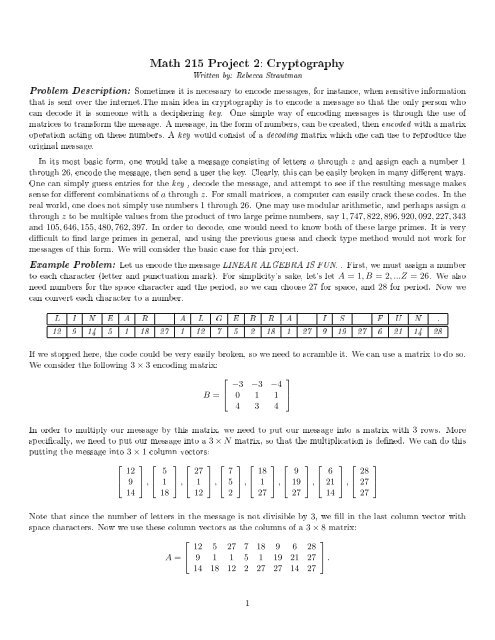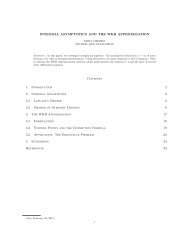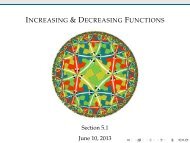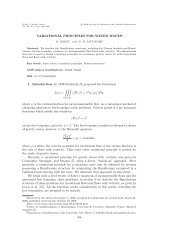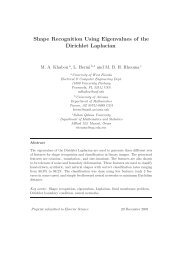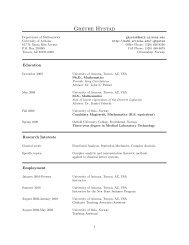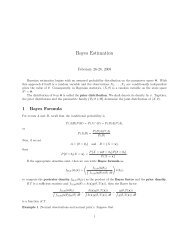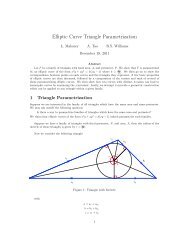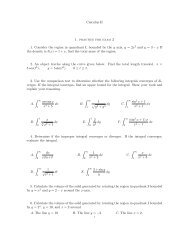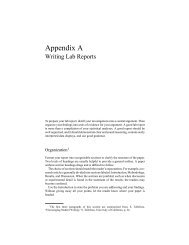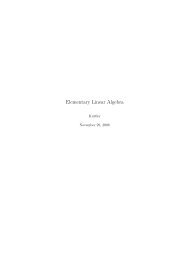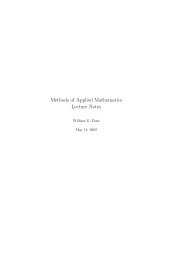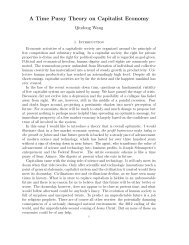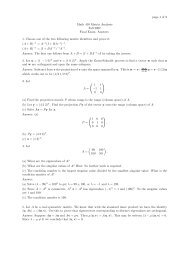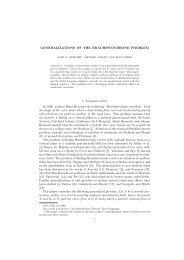Math 215 Project 2: Cryptography
Math 215 Project 2: Cryptography
Math 215 Project 2: Cryptography
Create successful ePaper yourself
Turn your PDF publications into a flip-book with our unique Google optimized e-Paper software.
<strong>Math</strong> <strong>215</strong> <strong>Project</strong> 2: <strong>Cryptography</strong><br />
Written by: Rebecca Strautman<br />
Problem Description: Sometimes it is necessary to encode messages, for instance, when sensitive information<br />
that is sent over the internet.The main idea in cryptography is to encode a message so that the only person who<br />
can decode it is someone with a deciphering key. One simple way of encoding messages is through the use of<br />
matrices to transform the message. A message, in the form of numbers, can be created, then encoded with a matrix<br />
operation acting on these numbers. A key would consist of a decoding matrix which one can use to reproduce the<br />
original message.<br />
In its most basic form, one would take a message consisting of letters a through z and assign each a number 1<br />
through 26, encode the message, then send a user the key. Clearly, this can be easily broken in many dierent ways.<br />
One can simply guess entries for the key , decode the message, and attempt to see if the resulting message makes<br />
sense for dierent combinations of a through z. For small matrices, a computer can easily crack these codes. In the<br />
real world, one does not simply use numbers 1 through 26. One may use modular arithmetic, and perhaps assign a<br />
through z to be multiple values from the product of two large prime numbers, say 1, 747, 822, 896, 920, 092, 227, 343<br />
and 105, 646, 155, 480, 762, 397. In order to decode, one would need to know both of these large primes. It is very<br />
dicult to nd large primes in general, and using the previous guess and check type method would not work for<br />
messages of this form. We will consider the basic case for this project.<br />
Example Problem: Let us encode the message LINEAR ALGEBRA IS FUN. . First, we must assign a number<br />
to each character (letter and punctuation mark). For simplicity's sake, let's let A = 1, B = 2, ...Z = 26. We also<br />
need numbers for the space character and the period, so we can choose 27 for space, and 28 for period. Now we<br />
can convert each character to a number.<br />
L I N E A R A L G E B R A I S F U N .<br />
12 9 14 5 1 18 27 1 12 7 5 2 18 1 27 9 19 27 6 21 14 28<br />
If we stopped here, the code could be very easily broken, so we need to scramble it. We can use a matrix to do so.<br />
We consider the following 3 × 3 encoding matrix:<br />
⎡<br />
−3 −3<br />
⎤<br />
−4<br />
B = ⎣ 0 1 1 ⎦<br />
4 3 4<br />
In order to multiply our message by this matrix, we need to put our message into a matrix with 3 rows. More<br />
specically, we need to put our message into a 3 × N matrix, so that the multiplication is dened. We can do this<br />
putting the message into 3 × 1 column vectors:<br />
⎡ ⎤ ⎡ ⎤ ⎡ ⎤ ⎡ ⎤ ⎡ ⎤ ⎡ ⎤ ⎡ ⎤ ⎡ ⎤<br />
⎣<br />
12<br />
9<br />
14<br />
⎦ , ⎣<br />
5<br />
1<br />
18<br />
⎦ , ⎣<br />
27<br />
1<br />
12<br />
⎦ , ⎣<br />
7<br />
5<br />
2<br />
⎦ , ⎣<br />
Note that since the number of letters in the message is not divisible by 3, we ll in the last column vector with<br />
space characters. Now we use these column vectors as the columns of a 3 × 8 matrix:<br />
⎡<br />
12 5 27 7 18 9 6<br />
⎤<br />
28<br />
A = ⎣ 9 1 1 5 1 19 21 27 ⎦ .<br />
14 18 12 2 27 27 14 27<br />
18<br />
1<br />
27<br />
⎦ , ⎣<br />
9<br />
19<br />
27<br />
⎦ , ⎣<br />
6<br />
21<br />
14<br />
⎦ , ⎣<br />
28<br />
27<br />
27<br />
⎦<br />
1
Multiplying the encoding matrix by our the message matrix gives:<br />
⎡<br />
−119 −90 −132 −44 −165 −192 −137 −273<br />
BA = ⎣ 23 19 13 7 28 46 35 54<br />
131 95 159 51 183 201 143 301<br />
⎤<br />
⎦<br />
The encoded message is the list the numbers in order of the column vectors (ie −119, 23, 131, −90, 19, 95, −132, . . . ).<br />
To decode this message, we would write these numbers as column vectors, and then multiply by the decoding matrix<br />
(the inverse of the encoding matrix). We have a decoding matrix of<br />
⎡<br />
B −1 = ⎣<br />
1 0 1<br />
4 4 3<br />
−4 −3 −3<br />
⎤<br />
⎦<br />
and clearly<br />
⎡<br />
⎣<br />
1 0 1<br />
4 4 3<br />
−4 −3 −3<br />
⎤ ⎡<br />
⎦ ⎣<br />
−119 −90 −132 −44 −165 −192 −137 −273<br />
23 19 13 7 28 46 35 54<br />
131 95 159 51 183 201 143 301<br />
⎤<br />
⎦ = B −1 BA = A<br />
which, with the numbers in order by column vector (12, 9, 14, 5, . . . = L, I, N, E, . . . ), is our original message.<br />
Assigned Problem: Use the previous method to translate a code into the original message. The following was<br />
used as an ENCODING matrix: ⎡<br />
⎤<br />
4 3 4 6 −2 −1<br />
8 9 4 −2 −2 −5<br />
−3 0 3 −1 1 2<br />
⎢ 8 9 8 9 8 −9<br />
.<br />
⎥<br />
⎣ 4 2 −2 3 0 0 ⎦<br />
4 3 −1 −1 4 5<br />
The encoded code is then<br />
272, 152, -53, 467, 167, 124, 64, -30, 69, 101, 35, 220, 249, 23, 36, 408, 77, 73, 299, 249, 6, 770, 159, 208, 157,<br />
155, 26, 418, 113, 223, 284, 386, 27, 496, 150, 320, 86, -92, 53, 10, 44, 159, 248, 66, 20, 555, 77, 42, 29, -31, 51,<br />
205, 66, 306, 279, 187, -67, 530, 167, 89, 248, 302, -7, 781, 173, 286, 228, 274, 69, 384, 94, 264, 202, -92, 89,<br />
458, 78, 230.<br />
Translate the code back into a message (using the same numbering convention A = 1, B = 2, etc).<br />
Note: When Matlab does computations, it will do everything in oating point arithmetic. Sometimes there will a<br />
condition known as roundo error in which a solution which would come out exact by hand comes out approximate<br />
on a computer. For this problem, you can safely assume that if Matlab returns numbers such as 8.000000000000014<br />
then the answer should really be 8.<br />
2


